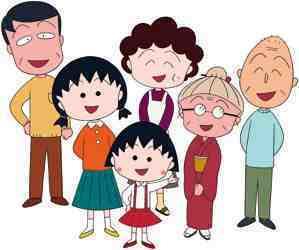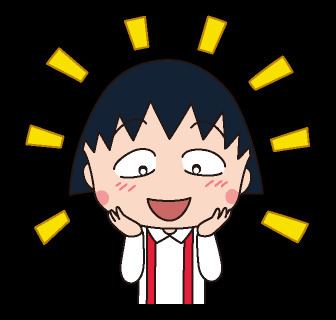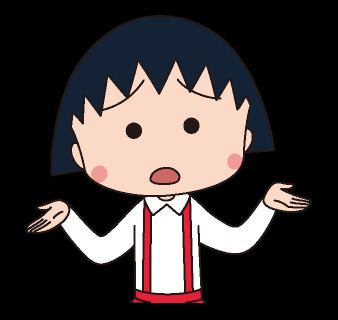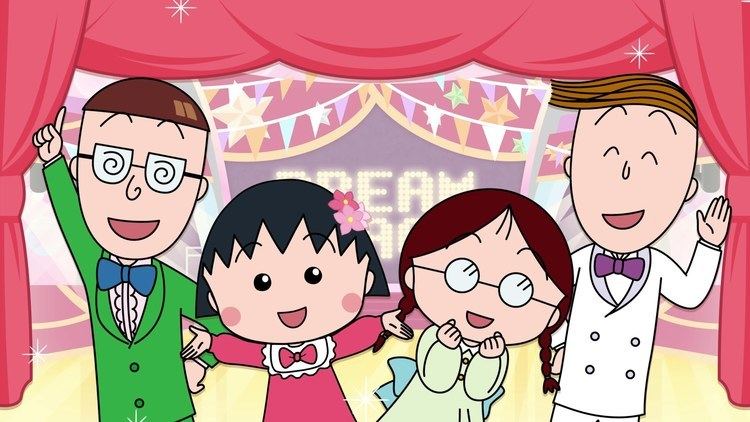Demographic Shōjo Volumes 15 | ||
 | ||
Original run August 1986 – June 1996 Adaptations Maru maru chibi Maruko-chan (2007) Similar Sazae‑san, Crayon Shin‑chan, Doraemon, Anpanman, Kochira Katsushika‑ku Kameari | ||
Chibi Maruko-chan (Japanese: ちびまる子ちゃん) is a shōjo manga series written and illustrated by Momoko Sakura. The series depicts the simple, everyday life of Momoko Sakura, a young girl everyone calls Maruko, and her family in suburban Japan in the year 1974. The series is set in the former city of Shimizu, now part of Shizuoka City, birthplace of its author.
Contents
- Themes
- Sakura family
- Marukos friends
- Other characters
- Manga
- First series
- Second series
- Live action
- Movies
- Video games
- References
The first story under the title "Chibi Maruko-chan" was published in the August 1986 edition of the shōjo manga magazine Ribon. Other semi-autobiographical stories by the author had appeared in Ribon and Ribon Original in 1984 and 1985, and were included in the first "Chibi Maruko-chan" tankōbon in 1987. The author first began writing and submitting strips in her final year of senior high school, although Shueisha (the publisher of Ribon and Ribon Original) did not decide to run them until over a year later. The author's intent was to write "essays in manga form"; many stories are inspired by incidents from her own life, and some characters are based on her family and friends. The nostalgic, honest and thoughtful tone of the strip led to its becoming popular among a wider audience.

Chibi Maruko-chan was adapted into an anime TV series by Nippon Animation, which originally aired on Fuji Television from January 7, 1990 to September 27, 1992. It has also spawned numerous games, animated films and merchandising, as well as a second TV series running from 1995 to the present. Maruko's style and themes are sometimes compared to the classic comic Sazae-san. In 1989, the manga tied to receive the Kodansha Manga Award for shōjo. As of 2006, the collected volumes of the manga had sold more than 31 million copies in Japan, making it the fifth best-selling shōjo manga ever.

Themes
The trademark face fault of this series, in reaction to an awkward "don't know what to say" situation (or sometimes, embarrassment) is the sudden appearance of vertical lines (黒い線, kuroi sen) on a character's face, sometimes with an unexplained gust of wind blowing above that character's head.Sakura family

Maruko's friends
Maruko's best friend. She is intelligent and she does not include herself in other activities with Maruko. Nicknamed Tama-chan. She also has a father whose favorite hobby is photography.
A rich boy in Maruko's class who lives in a mansion. His mom is always away travelling and so he doesn't see her that often. He's multilingual who sometimes speaking phrases and words in English and French along with his native Japanese and also has a butler, Mr. Hideji, who drives a limo and picks him up every day from school. Hanawa is mentioned to have a crush on Maruko. He was born on August 7, 1965.
Maruo is one of Maruko's classmates and serves as the male class president and always wants to be admired by others. He has very thick glasses because he is a very serious student and studies very hard every day; black lines appear on his face nearly all of the time, especially when he seems euphoric. He is paranoid that his classmates are seeking to replace him as male class president and will target classmates that stand out and do well to discourage them from running against him. His birthday is December 31, thus giving rise to his name.
He laughs non-stop about anything good or bad. He is also known as the "classroom idiot boy" (クラスのバカ男子) or "Class Clown".
A very weird, and creepy girl who always jokes usually on the macabre side. She also likes to make fun of others, especially Maruko. She often spies on people. It was revealed in one episode that she's the daughter of theatrical stage performers Shosuke and Fujio.
Other characters
Manga
The original Chibi Maruko-chan manga was serialized in the shōjo-oriented Ribon Magazine. 14 volumes were published from July 1987 to December 1996, with a 15th volume published in February 2003. On July 2007, a 4-frame version of Chibi Maruko-chan was published in every morning edition of several Japanese newspapers such as the Tokyo Shimbun and the Chunichi Shimbun.
The 16th volume of the manga was published on April 15, 2009.
First series
Chibi Maruko-chan originally aired on Fuji Television. 142 episodes were broadcast, from January 1990 to September 1992. Maruko was voiced by Tarako; other voice actors included Kappei Yamaguchi and Hideki Saijo. Original manga author Momoko Sakura wrote the teleplay for most episodes. The first series was directed by Yumiko Suda, animated by Masaaki Yuasa (who later directed Mind Game in 2004), while the music was composed by Nobuyuki Nakamura. The series attained a TV viewer rating of 39.9%, the highest rating ever attained by an animated TV series in Japan at the time. The outro song Odoru Ponpokorin became a hit and was interpreted by several artists including the KinKi Kids and Captain Jack. The series was exported throughout Asia and was especially popular in Taiwan. In addition, 65 episodes were dubbed into Arabic (called maruko-alsaghera, which means Little Maruko), where it garnered attention from people of all ages. It also aired in Germany with the same title as the original. It airs weekdays on Nick India in India.
Opening theme:
- Yume Ippai (ゆめいっぱい "Full of Dreams") by Yumiko Seki (eps. 1-142)
Ending themes:
- Odoru Pompokolin (おどるポンポコリン) by B.B.Queens (eps. 1-66)
- Hashire Shoujiki-mono (走れ正直者 "Run, Honest Person") by Hideki Saijou (eps. 67-142)
Second series
A second series debuted on Fuji Television in January 1995, airing on Sundays in the 6:00 pm time slot, before Sazae-san at 6:30 pm. The series is directed by Jun Takagi and Nobuyuki Nakamura, like the first series, composes the music. Majority of the voice actors from the first series reprised their role. The first 219 episodes were written by Momoko Sakura, however, she has supervised the episode screenplays since episode 220. This series was also dubbed into German and broadcast by RTL II, Super RTL and Jetix in Germany. In Spain, the show is available via VOD on the website of Neox's children's block, Neox Kidz. On TV Japan, which is available in the United States and Canada, the second series (starting with the episodes broadcast in 2009) now broadcasts weekly in Japanese. An Latin American dub was also produced and aired on Discovery Kids in Latin America and Televisa in Mexico.
Opening themes:
- Ureshii Yokan (うれしい予感 "Feeling Happy") by Marina Watanabe (eps. 1-73), Chibi Maruko-chan (Tarako) (ep. 28)
- Humming ga Kikoeru (ハミングがきこえる "Hear the Humming") by Kahimi Karie (eps. 74-179)
- Odoru Ponpokorin (おどるポンポコリン) by ManaKana & Shigeru Izumiya (eps. 180-253)
- KinKi no Yaruki Man Man Song (KinKiのやる気まんまんソング) by KinKi Kids (eps. 254-294)
- Odoru Ponpokorin (おどるポンポコリン) by B.B.Queens (eps. 295-746; 793-807; 888-953)
- Odoru Ponpokorin (2010 Version) (おどるポンポコリン(2010年バージョン)) by Kaela Kimura (eps. 747-792)
- Odoru Ponpokorin (25th Anniversary Version) (おどるポンポコリン(ちびまる子ちゃん誕生25周年バージョン)) by B.B. Queens (eps. 808-887)
- Odoru Ponpokorin (2014 Version) (おどるポンポコリン(2014年バージョン))(by E-Girls (eps. 954-1046)
- Odoru Ponpokorin by Sakurako Ohara (Special 19)
- Odoru Ponpokorin by Golden Bomber (eps. 1047-)
Ending themes:
- Hari-kiri Jiisan no Rock 'n' Roll (針切じいさんのロケン・ロール) by Hitoshi Ueki (eps. 1-27, 29-73)
- Hari-kiri Jiisan no Rock 'n' Roll by Grandfather (Takeshi Aono) and the children (ep. 28)
- Akke ni Torareta Toki no Uta (あっけにとられた時のうた) by Tama (eps. 74-130, 132-179)
- Yume Ippai Shin Version (ゆめいっぱい(新バージョン) "Full of Dream (New Version)")
- Jaga Buttercorn-san (じゃがバタコーンさん) by ManaKana (eps. 180-230)
- Chibi Maruko Ondo (ちびまる子音頭) by ManaKana (eps. 231-340)
- Kyuujitsu no Uta (Viva La Viva) (休日の歌(Viva La Vida)) by Delighted Mint (eps. 341-416)
- Uchū Dai Shuffle (宇宙大シャッフル "Big Shuffle in Outer Space") by Love Jets (eps. 417-481)
- Arara no Jumon (アララの呪文) by Chibi Maruko-chan with Bakuchu Mondai (eps. 482-850)
- Hyaku-man Nen no Shiawase!! (100万年の幸せ!! "The Happiness of 100 Thousand Years!!")by Kuwata Keisuke (eps. 851-)
- Kimi o Wasurenai yo (キミを忘れないよ "I Won't Forget You") by Sakurako Ohhara
Live action
A live action series was shown on Fuji Television in 2006. The series was created to commemorate Chibi Maruko-chan's 15th anniversary and had 3 episodes, each 2 hours. All costumes and hairstyles are faithful to the original manga.
Both the second television series and the live action series were broadcast in 1080i HDTV.
Movies
Video games
All the Game Boy titles (which consists of minigames) were developed by KID and published by Takara. The other titles were published by different companies like Namco, Konami, Epoch and Banpresto.
